Office 2016 vs Office 365 vs Office Online: what’s the difference?
We compare the many versions of Microsoft Office: perpetual, subscription-based and free
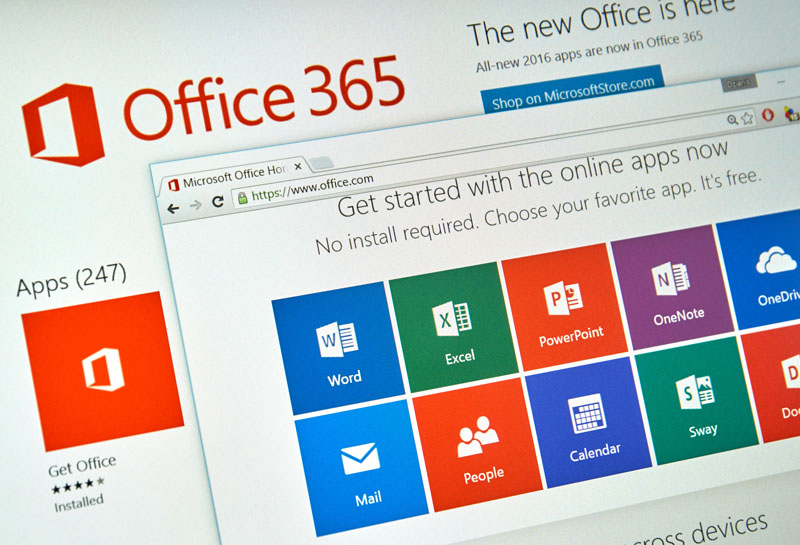

Microsoft's Office suite has gone through a great many iterations and changes since it originally launched in 1990 and although it's still a favourite of many (not even just Windows users either), it can be difficult to decide which type of Office subscription to go for.
Microsoft Office, whether you go for the company's Office 365, Office Online or standard desktop apps offering comprises Word (for word processing), Excel (spreadsheets) and PowerPoint (slide show presentation) – with a few more recent additions, including Access (database), Outlook (email) and OneNote (note-taking). These applications existed as standalone products before Microsoft decided to package them all together in a super-powerful productivity suite.
Office has grown to dominate the entire home and business productivity market throughout the 1990s and into the 2000s. Although there are some pretty big competitors today, including Google's own suite of apps via Google Drive, Microsoft has done well to keep up, changing and adapting its offering as computer trends have demanded.
If you're a little puzzled about whether to buy Office 365, Office Online or Office 2016, or you’re unsure whether it’s worth investing in the more expensive options, look no further than our comparison, which details what each version offers in terms of features, integrations and more.
Latest news
31/08/2018: Microsoft ends limits on Office 365 installations
Microsoft will no longer limit the number of devices that Office 365 subscribers can install on, after previously capping. Before, Office 365 Home subscribers were limited to five users across ten devices, while Personal was limited to one computer and one tablet.
As of 2 October, that will change, with subscribers allowed to install on an unlimited number of devices. Plus, Home subscribers will get an extra user account, increasing from five to six.
There is a limit to how many devices you can be signed into at any one time, however. If you're signed into five and try to login to a sixth, you'll be told "limit reached" and asked to sign out elsewhere. The move appears to be recognition that many of us have more than two devices, and arrives with no change in price.
Microsoft is also tweaking the Home subscription to better integrate better with your family members, by automatically sharing you subscription with anyone you've named as family.
To see what devices you've installed on and who you share your subscription with, you can now head to account.microsoft.com.
14/08/2017: Microsoft 365 has been enhanced with a new feature set aimed at small businesses, including Microsoft Connections, Microsoft Listings and Microsoft Invoicing.
Microsoft Connections is an email marketing platform at helps businesses create personalised marketing campaigns with templates for newsletters, announcements or customer referrals. It also combines the ability to create great looking emails with the contacts management too, allowing you to segment users based on certain metrics to take advantage of better email targeting.
Everything you send out can be tracked, with stats such as performance charts, subscriber activity updates, clicks, new sign-ups, new customers, offer redemptions and unsubscribed numbers available for each campaign.
Microsoft Listings is a local listings tool to help you manage where your business is advertised and the information that is displayed. For example, it makes it easier to update your opening hours, address or other information related to your business across Facebook, Google, Bing and Yelp.
To make it easier to send and track invoices, Microsoft Invoicing is also available for Office 365 Business users. It ensures companies are paid what they're owed on time, without the hassle of having to deal with paper. The great thing is that Microsoft Invoicing also integrates with PayPal and Quickbooks for ultimate flexibility.
Other announcements to benefit small businesses include a new 365 Business Centre where companies can manage their Bookings, Connections, Listings and Invoicing tools, plus manage their data and apps in one place, and MileIQ, which is now available to Office 365 Business Premium customers.
14/07/2017: Microsoft has rolled out a new feature in Office 365 which allows administrators to deploy Office web add-ins.
Called Centralized Deployment, the feature has been in preview mode for a while but can now be used by the wider install base of the cloud-based productivity suite.
According to a blog post, administrators can deploy Office web add-ins to individual users, groups or an organization with ease, from the Office 365 admin centre or by using PowerShell scripts.
Microsoft said that users can open Office applications—such as Word, Excel or PowerPoint on Windows, Mac or Office Online—to see the add-ins installed on their ribbon. “This allows organizations—large and small—to easily extend Office with high-value services across all platforms,” said the company.
The feature supports users in top-level groups, Office 365 Groups, distribution lists and security groups that are top-level groups supported by Azure Active Directory. It requires a recent version of Microsoft Office and OAuth enabled version of Exchange. IT admins can run a quick test to ensure compatibility and determine if their organization has the correct configuration prior to getting started.
21/06/2016: Microsoft has announced a series of updates to its Office 365 Education offering that it claims will help increase collaboration and development in professional learning community (PLC) groups.
To do this, Microsoft has developed a customised Office 365 Groups function for PLC groups, where they can share files through OneDrive, access and create shared calendars, and have shared OneNote files and conversation spaces that are exclusive to group members.
Another update is to content sharing platform, Docs.com. This platform is normally tipped as a way for Office 365 users to share their creations with the world. However, Microsoft said that feedback indicated this was not ideal in an educational setting and that "keeping things a little more private sometimes makes students and teachers feel safer about distributing their work".
In response, Microsoft is introducing an Organisation Visibility feature, which lets users decide who can see their work, such as only those with an Office 365 School account or only those working within the same organisation.
Finally, Microsoft has updated Forms, a feature exclusive to Office 365 Education that allows teachers to manage classes, collaborate and share information about students, and also set up quizzes for students to take.
With this update, Microsoft Forms now features auto-grading, allowing teachers to mark assignments without needing any additional add-ons as they had in the past, and also real-time, personalised feedback, which enables teachers to provide students with instant feedback on quizzes for each question and answer.
Office 365
5/5
PRO Always have the latest versions of Office
PRO Accessible online, on mobile and on the desktop
PRO Collaborative working and communication
Details
https://products.office.com/en-gb/business/compare-office-365-for-business-plans
https://products.office.com/en-gb/business/compare-more-office-365-for-business-plans
Price
Office 365 Business Premium, £7.80 per user, per month (annual commitment)
Office 365 ProPlus, £10.10 per user, per month (annual commitment)
System requirements
Windows 7 SP1/8/8.1/10/Server 2008 R2/Server 2012 R2/Windows 10 Server, 1GHz x86 or x64 processor, 2GB RAM, 3GB disk space, 1,280x800 resolution display
Mac OS X 10.10+, Intel-based Mac, 4GB RAM, 6GB disk space, 1,280x800 resolution display
Internet connection
Office 365 is Microsoft's flagship product for both home and business users. Its subscription model has obvious advantages for Microsoft, but also means that some companies that would normally only upgrade their software every other generation end up spending more on Office than they would otherwise.
However, the deal has potential benefits for your business, too: your staff will always have the latest version of all Office software, everything is securely backed up to the cloud by default, and the monthly fee can be classed as an operating expense, as opposed to the large one-off capital expenditure of buying software licences, which some businesses may prefer to avoid having to budget for.
While perpetual Office 2016 licences are sold on a per-computer basis, Office 365 subscriptions are per user. Each of your users can install Office on up to five PCs, five tablets, and five phones, making it easy for them to work between their office desktop, home PC, laptop, tablet, phone and any other devices they might regularly use. The only exception is the online-only Office 365 Essentials subscription, priced at £3.10 per user, per month, which only gives you access to the online versions of the Office apps plus some extra cloud communication, storage features and a proper business user licence that free Office Online users don't get.
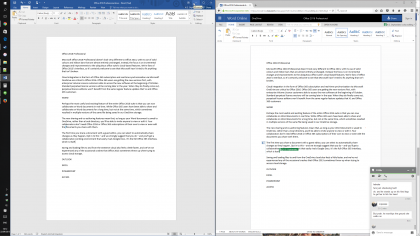
Side-by-side comparison of Word desktop and Word online editing interfaces
Office 365 has some features that are only possible because it is a cloud-based service, most notable of which are VoIP telephony and video conferencing through Skype for Business, an email server for your domain that gives each user 50GB of inbox storage, 1TB of OneDrive cloud storage per user, and desktop, mobile, and web apps that are all linked to the same user account, making it easy to ensure that your staff don't lose track of their files between multiple software installations.
Microsoft has recently announced new cloud-based features for Office 365 too, including the introduction of Translator access directly from Word (allowing people to translate chunks of their text into up to 60 languages in real time), the addition of Immersive Reader and Read Aloud for Word on iPad and OneDrive Files On-Demand, which means users can access their OneDrive and SharePoint files without filling up their disk space.
"Office 365 provides the broadest and deepest set of apps and services with a universal toolkit for teamwork, giving people flexibility and choice in how they connect, share, and communicate," Kirk Koenigsbauer, corporate vice president for the Office team said.
"New apps and features help organizations of all sizes around the globe accelerate their digital transformation and allow every user to produce compelling content that is accessible to all."
For European Office 365 users, Microsoft's data centres are located in Ireland, the Netherlands, Austria and Finland, which means that you'll be compliant with EU data protection Directive 95/46/EC if you need to store customers' personal data. Additionally, for large enterprises with similarly large budgets, bespoke hybrid on-site/remote cloud storage options are available.
The most useful aspect of Office 365 for many businesses is likely to be its collaboration and co-authoring capabilities. Word, PowerPoint and note-jotting app OneNote all support real-time collaboration on the same document, regardless of whether users are accessing it via the web or a desktop application. Sadly, the desktop version of Excel doesn't yet have this feature, but Excel Online supports multi-user real-time collaboration.
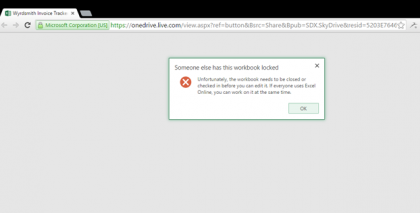
You can invite people to edit your Excel workbooks, but if you have it open in Excel, they won't be able to editing using Excel Online
With Microsoft's acquisition of business social network LinkedIn, Office 365 users can also view LinkedIn information from their Outlook email accounts, starting with Outlook.com users. Microsoft explained it provides "rich insights, profile pictures, work history, and more, right from within your personal inbox."
Online collaboration via Office 365 can feel a little sluggish compared to rival Google Apps for Work, but a wider range of features, such as a real-time word count in Word Online and some surprisingly capable charting options in Excel Online, as well as the familiar ribbon interface, mean that the online and mobile versions of the apps provide users with a powerful and approachable set of tools.
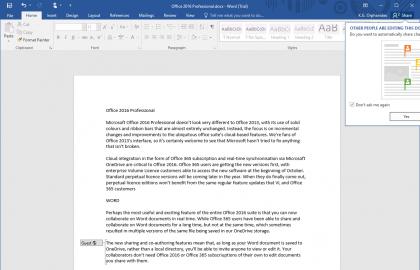
Word clearly shows you who's contibuting which changes to your shared documents
Although Access comes as standard with both Home and Personal subscriptions of Office 365, which aren't licenced for business use, enterprise subscribers only get Microsoft's database suite if they subscribe at ProPlus level or above.
A dizzying array of subscription options are available, but the most useful for a business that wants to move its key services to the cloud is Office 365 Business Premium, priced at £7.80 per user, per month if you opt for an annual commitment (month-to-month contracts cost £9.40 per user).
This gets you all the Office applications, except Access, plus email and plenty of storage. If you need Access, the ProPlus version of Office 365 costs £10.10 per user, per month, while larger enterprises can spend more to get features such as unlimited email storage, archiving services in compliance with finance industry standards and advanced cloud-based IP telephony systems.
Office 2016
5/5
PRO Allows you to independently decide when to upgrade
PRO Outstanding office and productivity suite
CON Stand-alone installations don't benefit from collaborative working options
Price
Office Home & Business 2016, £163 ex VAT
Office Professional 2016, £275 ex VAT
Details
https://products.office.com/en-gb/buy/compare-microsoft-office-products
System requirements
Windows 7 SP1/8/8.1/10/Server 2008 R2/Server 2012 R2/Windows 10 Server, 1GHz x86 or x64 processor, 2GB RAM, 3GB disk space, 1,280x800 resolution display
Mac OS X 10.10+, Intel-based Mac, 4GB RAM, 6GB disk space, 1,280x800 resolution display
Microsoft's current version of Office, 2016, is what you'll be using regardless of whether you get a new perpetual licence or subscribe via Office 365 at the moment. There are a number of different perpetual licence versions available, both individually and through volume licencing (VL).
Unlike an Office 365 subscription, you'll have to choose at the time of purchase whether you want a copy for Mac OS X or Windows. Each licence only covers you for a single computer and, although a number of server and cloud integration options are available for VL customers, you don't get any online storage, syncing or collaboration features by default.
For UK businesses buying individual licences, Office Home & Business 2016 is priced at £195 inc VAT and Office Professional 2016 costs £330 inc VAT. Both come with Word, Excel, PowerPoint and Outlook, but only the Professional version gets you Publisher and Access.
Compared to previous versions of Office, the most notable changes you'll see in Office 2016 include searchable tools and features via the "tell me what you want to do" bar, Bing integration, powerful new web app development features in Access, and some major updates to Excel's data importation and handling features. These include new chart styles, updated pivot tables and improved forecasting tools.
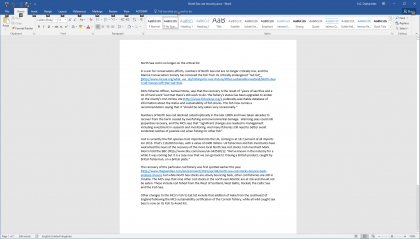
Office 2016 desktop applications look and feel much like Office 2013
Typical perpetual licence users won't be able to advantage of the collaboration and co-working features that represent some of the biggest changes between Office 2013 and 2016. Larger enterprises that require collaboration features and don't want to rely on externally hosted cloud services may wish to consider on-premises installations of SharePoint 2016 (currently in beta) and Office Online Server (currently available as a preview version) as alternatives to Office 365.
Microsoft Office remains the industry standard, and with good reason. Excel, in particular, is the jewel in Office's crown: other spreadsheets seem very lightweight and lacking in features by comparison. Office 2016 hasn't made any radical changes to the basic formula of 2013 - a good thing, as it means that upgrading won't require you to retrain staff - but presents a range of small improvements. If you're currently running Office 2013 perpetual licences, however, there's no compelling reason to upgrade for most businesses.
Office Online
3/5
PRO Free
PRO Works on almost any browser or mobile device
CON Not designed or licenced for business use
Price
Free
Details
Office Online is a free, surprisingly comprehensive web-based office suite, comprising the same cut-down versions of most of Microsoft's standard Office applications that you get as part of the Office 365 web interface. It's explicitly aimed at home users and provides a free, quick and easy way to work with Microsoft's default document formats without being tied to a particular computer.
Office Online includes browser-based versions of Word, Excel, PowerPoint, OneNote and Outlook. There's also a Calendar, the People contact book, Docs sharing and Sway, a relatively recent 'digital storytelling' app that lets you quickly assemble presentations, photo slideshows and newsletters. It's a simple PowerPoint alternative, but the results are better geared for sharing on the web, and you can easily embed content from social media.
All your documents are automatically saved to a free 5GB OneDrive account - users who've had their Microsoft account for a long time may have more space available to them. You can use this to sync files to any Windows PC that you've connected to the same Microsoft account. Files are saved in standard Office 2016 formats (DOCX, XLSX, etc.), so you'll be able to open them using any compatible software. By comparison, Google Apps for Work uses a proprietary format and requires you to export files if you wish to use them with other software.
Unlike Google Apps, you can't enable any kind of offline editing mode for Office Online - if your internet connection goes down, so does your ability to work. If you want to work offline, you'll need to subscribe to Office 365 at a level that provides desktop versions of the software. At least Chrome users get an extension that lets you quickly open and create files via a browser button.
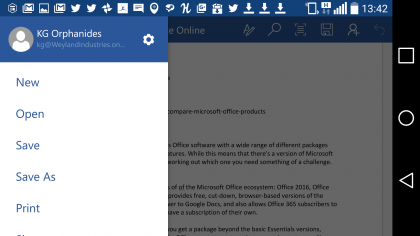
The mobile version of Word fits plenty of features into a compact screen
As in Office 365's Online apps, the free version of Office Online allows you to collaborate in real time with other users: the feature is supported in Word, PowerPoint, OneNote and Excel. Your free Office Online account can also be used to sign in to the mobile apps on Android, iOS and Windows Phone, giving you on-the-go access to your files.
The mobile versions of the apps have most of the same features as their browser equivalents, although they're first and foremost set up for quick viewing and text entry. Tablet users get the familiar ribbon interface laid out almost identically to that of Office Online. If you're on a phone, everything's by necessity a bit more compact, but all the same options for formatting and reviewing your documents are available via a menu.
Conclusions
Office 2016 is a worthy update to the venerable productivity suite, although, with the exception of some specialist upgrades to Excel and Access, most perpetual licence users will find little to justify an immediate upgrade from Office 2013. Mainstream support doesn't end for Office 2013 until October 2018.
For small businesses in particular, the Office 365 Business and ProPlus subscription options have plenty to commend them, most notably the licence for users to install Office software on multiple computers and devices and the ability to collaborate with colleagues in real time.
The competing Google Apps for Work is, at £3.30 per user, per month, a cheaper and entirely realistic alternative for businesses that want to have their document editing, mail server and storage on a Software as a Service basis. Even so, Microsoft's powerful desktop applications are a strong justification for the £7.80 monthly cost per Office 365 Business Premium licence.
Office Online isn't designed for use in business, but if your business doesn't regularly use Microsoft software, the free service provides a useful alternative to expensive licence or subscription fees if you just want to occasionally check the formatting of an XLSX file before sending it to a client.
Get the ITPro daily newsletter
Sign up today and you will receive a free copy of our Future Focus 2025 report - the leading guidance on AI, cybersecurity and other IT challenges as per 700+ senior executives

Clare is the founder of Blue Cactus Digital, a digital marketing company that helps ethical and sustainability-focused businesses grow their customer base.
Prior to becoming a marketer, Clare was a journalist, working at a range of mobile device-focused outlets including Know Your Mobile before moving into freelance life.
As a freelance writer, she drew on her expertise in mobility to write features and guides for ITPro, as well as regularly writing news stories on a wide range of topics.
-
 Why keeping track of AI assistants can be a tricky business
Why keeping track of AI assistants can be a tricky businessColumn Making the most of AI assistants means understanding what they can do – and what the workforce wants from them
By Stephen Pritchard
-
 Nvidia braces for a $5.5 billion hit as tariffs reach the semiconductor industry
Nvidia braces for a $5.5 billion hit as tariffs reach the semiconductor industryNews The chipmaker says its H20 chips need a special license as its share price plummets
By Bobby Hellard